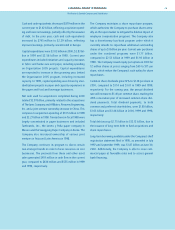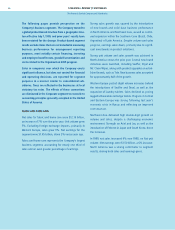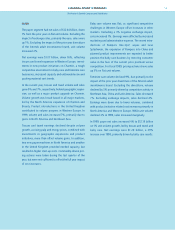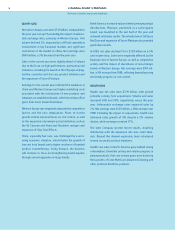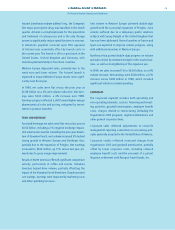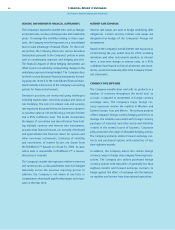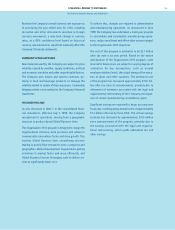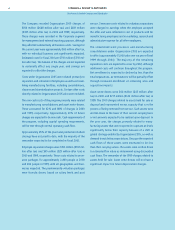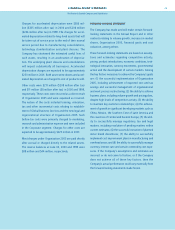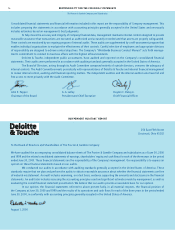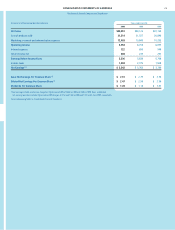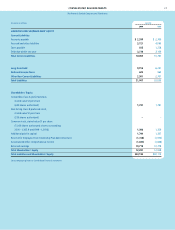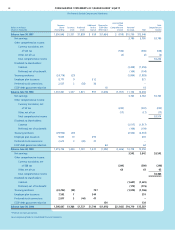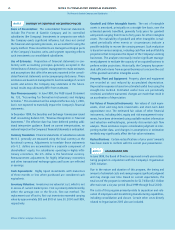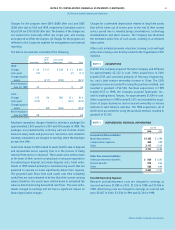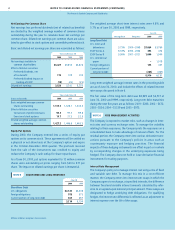Proctor and Gamble 2000 Annual Report Download - page 24
Download and view the complete annual report
Please find page 24 of the 2000 Proctor and Gamble annual report below. You can navigate through the pages in the report by either clicking on the pages listed below, or by using the keyword search tool below to find specific information within the annual report.
FINANCIAL REVIEW (CONTINUED)
The Procter & Gamble Company and Subsidiaries
22
The Company recorded Organization 2005 charges of
$814 million ($688 million after tax) and $481 million
($385 million after tax) in 2000 and 1999, respectively.
These charges were recorded in the Corporate segment
for management and external reporting purposes, although
they affected substantially all business units. Savings for
the current year were approximately $65 million after tax,
with no individual business unit significantly impacted.
Estimated costs for fiscal 2001 are $750 million ($550 mil-
lion after tax). The balance of the charges are not expected
to materially affect any single year, and savings are
expected to offset the charges.
Costs under Organization 2005 were related primarily to
separation and relocation of employees as well as stream-
lining manufacturing facilities, including consolidations,
closures and standardization projects. Certain other costs
directly related to Organization 2005 also were included.
The non-cash costs of the program primarily were related
to manufacturing consolidations and asset write-downs.
These accounted for 62% and 88% of charges in 2000
and 1999, respectively. Approximately 30% of future
charges are expected to be non-cash. Cash requirements of
the program, including capital spending requirements,
will be met through normal operating cash flow.
Approximately 45% of the plant and production module
closings have occurred to date, with the majority of the
remainder expected to be completed in fiscal 2001.
Employee separation charges were $153 million ($102 mil-
lion after tax) and $45 million ($29 million after tax) in
2000 and1999, respectively. These costs related to sever-
ance packages for approximately 2,800 people in 2000
and 400 people in 1999, with all geographies and busi-
nesses impacted. The predominantly voluntary packages
were formula driven, based on salary levels and past
service. Severance costs related to voluntary separations
were charged to earnings when the employee accepted
the offer and were reflected in cost of products sold for
manufacturing employees and in marketing, research and
administrative expense for all other employees.
The streamlined work processes and manufacturing
consolidations under Organization 2005 are expected
to affect approximately 15,000 jobs over six years (fiscal
1999 through 2004). The majority of the remaining
separation costs are expected to occur by 2002, although
additional costs will continue throughout the program.
Net enrollment is expected to decline by less than the
total separations, as terminations will be partially offset
through increased enrollment at remaining sites and
acquisition impacts.
Asset write-downs were $64 million ($43 million after
tax) in 2000 and $217 million ($142 million after tax) in
1999. The 2000 charges related to assets held for sale or
disposal and represented excess capacity that is in the
process of being removed from service. Such assets were
written down to the lower of their current carrying basis
or net amounts expected to be realized upon disposal. In
the prior year, the charges primarily related to manu-
facturing assets that were expected to operate at levels
significantly below their capacity because of a shift in
global strategy enabled by Organization 2005, as well as
demand trends below expectations. Because the expected
cash flows of those assets were estimated to be less
than their carrying values, the assets were written down
to estimated fair value as determined using discounted
cash flows. The remainder of the 1999 charges related to
assets held for sale. Asset write-downs will not have a
significant impact on future depreciation charges.





